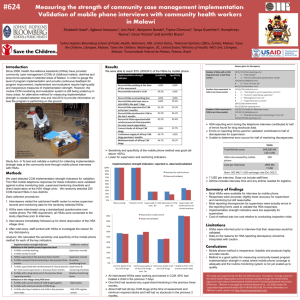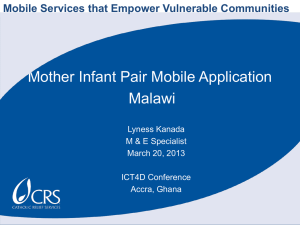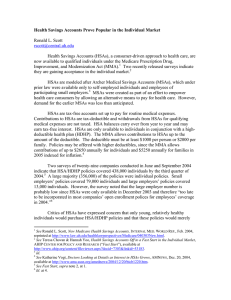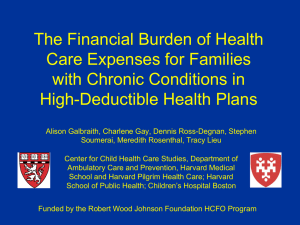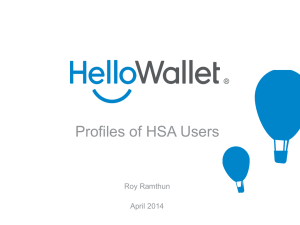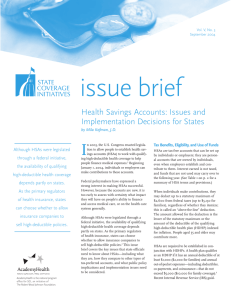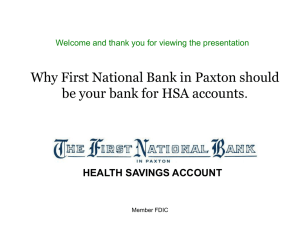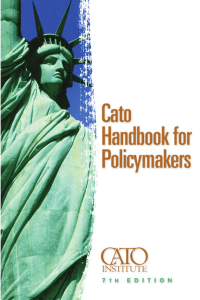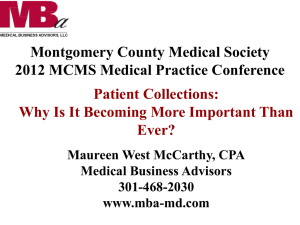HSA Policy Perplexities By Laura Hermer, J.D., L.L.M.
advertisement
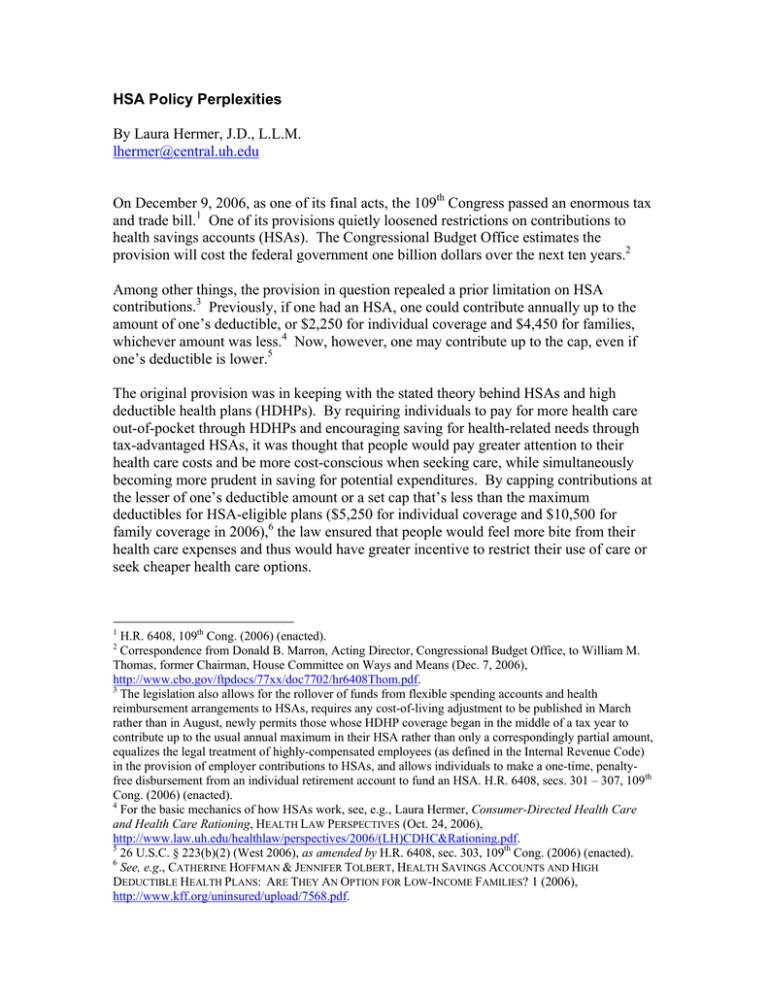
HSA Policy Perplexities By Laura Hermer, J.D., L.L.M. lhermer@central.uh.edu On December 9, 2006, as one of its final acts, the 109th Congress passed an enormous tax and trade bill.1 One of its provisions quietly loosened restrictions on contributions to health savings accounts (HSAs). The Congressional Budget Office estimates the provision will cost the federal government one billion dollars over the next ten years.2 Among other things, the provision in question repealed a prior limitation on HSA contributions.3 Previously, if one had an HSA, one could contribute annually up to the amount of one’s deductible, or $2,250 for individual coverage and $4,450 for families, whichever amount was less.4 Now, however, one may contribute up to the cap, even if one’s deductible is lower.5 The original provision was in keeping with the stated theory behind HSAs and high deductible health plans (HDHPs). By requiring individuals to pay for more health care out-of-pocket through HDHPs and encouraging saving for health-related needs through tax-advantaged HSAs, it was thought that people would pay greater attention to their health care costs and be more cost-conscious when seeking care, while simultaneously becoming more prudent in saving for potential expenditures. By capping contributions at the lesser of one’s deductible amount or a set cap that’s less than the maximum deductibles for HSA-eligible plans ($5,250 for individual coverage and $10,500 for family coverage in 2006),6 the law ensured that people would feel more bite from their health care expenses and thus would have greater incentive to restrict their use of care or seek cheaper health care options. 1 H.R. 6408, 109th Cong. (2006) (enacted). Correspondence from Donald B. Marron, Acting Director, Congressional Budget Office, to William M. Thomas, former Chairman, House Committee on Ways and Means (Dec. 7, 2006), http://www.cbo.gov/ftpdocs/77xx/doc7702/hr6408Thom.pdf. 3 The legislation also allows for the rollover of funds from flexible spending accounts and health reimbursement arrangements to HSAs, requires any cost-of-living adjustment to be published in March rather than in August, newly permits those whose HDHP coverage began in the middle of a tax year to contribute up to the usual annual maximum in their HSA rather than only a correspondingly partial amount, equalizes the legal treatment of highly-compensated employees (as defined in the Internal Revenue Code) in the provision of employer contributions to HSAs, and allows individuals to make a one-time, penaltyfree disbursement from an individual retirement account to fund an HSA. H.R. 6408, secs. 301 – 307, 109th Cong. (2006) (enacted). 4 For the basic mechanics of how HSAs work, see, e.g., Laura Hermer, Consumer-Directed Health Care and Health Care Rationing, HEALTH LAW PERSPECTIVES (Oct. 24, 2006), http://www.law.uh.edu/healthlaw/perspectives/2006/(LH)CDHC&Rationing.pdf. 5 26 U.S.C. § 223(b)(2) (West 2006), as amended by H.R. 6408, sec. 303, 109th Cong. (2006) (enacted). 6 See, e.g., CATHERINE HOFFMAN & JENNIFER TOLBERT, HEALTH SAVINGS ACCOUNTS AND HIGH DEDUCTIBLE HEALTH PLANS: ARE THEY AN OPTION FOR LOW-INCOME FAMILIES? 1 (2006), http://www.kff.org/uninsured/upload/7568.pdf. 2 But now, for those who have both enough money to do so and HDHPs with deductibles lower than the cap, it will become easier to contribute enough money to one’s HSA to cover not only one’s deductible and other permitted health expenses, but also to have enough left over to contribute to a growing nest egg for retirement. After one reaches age 65, funds in HSAs may be withdrawn and used for any purpose, not just for health care. If they are used for permitted health expenses, then they are not taxed.7 If they are used for other purposes, then they are taxed just like funds from an individual retirement account (IRA), and result in no penalty to the taxpayer.8 Those who may be in a better position to take advantage of the tax benefits of HSAs appear to be doing so in greater numbers than those who may not. Proponents of HDHPs and HSAs claim that the alleged cheapness of such plans make them more affordable for lower-income, previously-uninsured individuals.9 Yet it appears that at least two recent studies found that wealthier, healthier, and better-educated people are taking them up in disproportionate numbers.10 Individuals questioned in each study - one by the Kaiser Family Foundation (Kaiser) and the other by the Employee Benefits Research Institute (EBRI) - cited lower premiums and tax-preferred savings as most important in their decisions to take up an HDHP with an HSA.11 Both reports also indicated consumer problems with HDHPs. On the one hand, individuals in HDHPs with HSAs were somewhat more cost-conscious than their control group peers.12 On the other hand, a majority did not trust their plans’ information regarding cost-comparison.13 Additionally, in both studies, individuals in HDHPs with HSAs were substantially less likely to give their plans a high rating on satisfaction with 7 26 U.S.C § 223(f)(1). 26 U.S.C §§ 223(f)(2), (f)(4)(c). 9 See, e.g., The White House, Fact Sheet: Health Savings Accounts: Affordable and Accessible Health Care (Apr. 5, 2006), available at http://www.whitehouse.gov/news/releases/2006/04/20060405-6.html; Derek Hunter, Health Savings Accounts: The News Keeps Getting Better (Sept. 6, 2005), available at http://www.heritage.org/Research/HealthCare/wm833.cfm. 10 See KAISER FAMILY FOUNDATION, NATIONAL SURVEY OF ENROLLEES IN CONSUMER-DIRECTED HEALTH PLANS 2 (2006), http://www.kff.org/kaiserpolls/upload/7594.pdf; Paul Fronstin & Sara R. Collins, The 2nd Annual EBRI/Commonwealth Fund Consumerism in Health Care Survey, 2006: Early Experience With High-Deductible and Consumer-Driven Health Plans, ISSUE BRIEF NO. 300 9 – 10 (2006), http://www.ebri.org/pdf/notespdf/EBRI_Notes_12-20061.pdf. The EBRI study is more detailed in certain respects than the Kaiser study, and found that while a large majority of those who purchased HDHPs with HSAs on the individual market considered themselves to be in excellent health, only slightly more than the majority of those with employment-based HDHPs with HSAs considered themselves to be similarly healthy. Fronstin & Collins, supra, at 9. The EBRI study additionally considered individuals in HDHPs without HSAs, but those data are not included here. 11 Kaiser Family Foundation, supra note 10, at 2; Fronstin & Collins, supra note 10, at 14. Conversely, the EBRI study found the two most important reasons cited by individuals in comprehensive plans for having taken up their plans were good provider networks and low out-of-pocket costs. Fronstin & Collins, supra, at 14. 12 Kaiser Family Foundation, supra note 10, at 3. They were also moderately more likely to have avoided filling a prescription, skipped recommended treatment or failed to seek care than members of the control group. Id. at 6. 13 Id. at 4. 8 costs than were individuals in comprehensive plans.14 Notably, far more individuals in HDHPs with HSAs would be very or somewhat likely to change their plans if given the opportunity than those in the control group.15 At present, only slightly over one percent of all Americans have an HDHP with an HSA. They have not taken off in popularity, and the number of people with such plans did not increase at all in 2006 as compared with the previous year.16 Given the results of nonindustry surveys evaluating characteristics and plan satisfaction of individuals with HDHPs and HSAs, it’s perplexing why the 109th Congress would want to add an additional one billion dollars in subsidies to promote these plans, particularly when it’s also cutting taxes in numerous other areas and slashing spending on core programs for less well-to-do such as Medicaid, to name only a handful of matters. It would be one thing if HDHPs with HSAs were merely unpleasant but necessary medicine for American patients, and were doing an admirable initial job of holding down costs while providing adequate and less-expensive care for all. But this is not quite so. Perhaps somewhat like managed care plans in the early 1990s, the self-selection of healthier individuals into HDHPs with HSAs may be contributing to the modestly lower costs and cost increases that were found by at least one study.17 Constructive address of unsustainable cost increases and declining coverage will require more than putting more of patients’ “skin in the game.” We need instead to tackle the hard, underlying problems. December 2006 14 Id. at 5 (41 percent versus 60 percent); Fronstin & Collins, supra note 10, at 13 (20 percent versus 46 percent). 15 Kaiser Family Foundation, supra note 10, at 5 (50 percent versus 33 percent). The EBRI study asked a slightly different question, and found that, if given the opportunity to switch plans, only 36 percent of individuals in HDHPs with HSAs would keep their current plan, as compared with 63 percent of those currently in comprehensive plans. Fronstin & Collins, supra note 10, at 16. 16 Fronstin & Collins, supra note 10, at 6. 17 See Melinda Beeuwkes Buntin et al., Consumer-Directed Health Care: Early Evidence About Effects On Cost And Quality, HEALTH AFFAIRS WEB EXCLUSIVE (2006), http://content.healthaffairs.org/cgi/reprint/25/6/w516.

